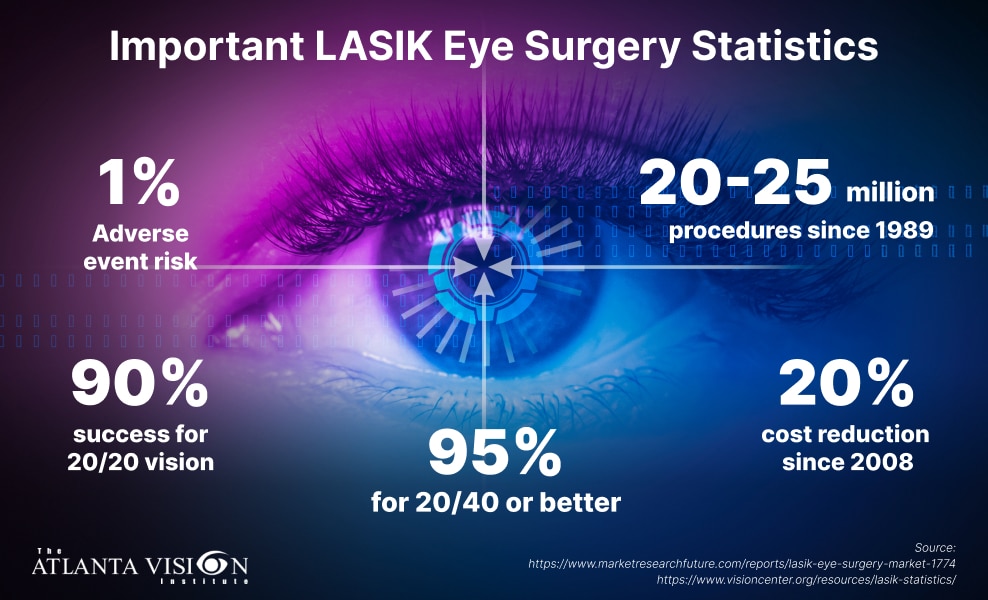
Deciding to undergo LASIK (Laser-Assisted In Situ Keratomileusis) eye surgery is an exciting time. You’ve likely spent a lot of time researching the results and picturing your life glasses-free, but you might be curious to know how long has LASIK been around.
Understanding the history of LASIK can help potential patients feel more confident and assured about the procedure. In this blog post, we’ll delve into when LASIK surgery was invented and more laser eye surgery history, from its early development to advanced techniques.
How Long Has Laser Eye Surgery Been Around?
Laser eye surgery has been around for several decades, tracing back to the late 1970s. The initial developments in vision correction began with radial keratotomy (RK), a procedure that involved making small incisions in the cornea to alter its shape and improve vision.
The true breakthrough came in the 1980s with the introduction of excimer lasers, which allowed for more precise and controlled reshaping of the cornea. This technological advancement paved the way for the modern laser eye surgeries we know today.
Who Developed Laser Eye Surgery?
The development of laser eye surgery is credited to several pioneering ophthalmologists. One of the early innovators was Dr. Svyatoslav Fyodorov, who developed RK. The real transformation came with the invention of the excimer laser first used for photorefractive keratectomy (PRK) by Dr. Stephen Trokel and his colleagues in 1987.
When Was LASIK Surgery Invented?
LASIK has been around since 1989 when Dr. Ioannis Pallikaris performed the first LASIK procedure. It revolutionized vision correction by introducing a technique that created a thin flap in the cornea, allowing for the underlying tissue to be reshaped with an excimer laser and then repositioning the flap. This method significantly reduced discomfort and recovery time compared to previous procedures.
The Rise of Modern LASIK
Since its inception, LASIK has continually evolved, benefiting from advancements in technology and technique. The 1990s and 2000s saw widespread adoption of LASIK, with millions of people worldwide opting for this procedure to improve their vision.
Modern LASIK procedures incorporate cutting-edge technology, such as bladeless femtosecond lasers and wavefront-guided techniques, ensuring highly precise and personalized treatments.
How LASIK Became a Popular Choice
The popularity of LASIK can be attributed to its impressive success rates and patient satisfaction. The procedure’s safety and effectiveness, combined with the convenience of quick recovery times, have made LASIK the preferred choice for vision correction.
Important LASIK Eye Surgery Statistics
Over the years, LASIK has been extensively studied and refined, resulting in impressive success rates and high levels of patient satisfaction. Here are some key statistics that highlight the benefits and outcomes of LASIK:
What Technological Advancements Have Improved LASIK?
Over the years, LASIK has benefited from numerous technological advancements, making the procedure safer, more precise, and more effective. Some of the key technological improvements include:
Bladeless Femtosecond Lasers
Traditional LASIK involved creating a corneal flap with a microkeratome blade. The introduction of femtosecond lasers allowed for bladeless flap creation, resulting in a more precise and customizable procedure. This advancement has reduced the risk of complications and improved patient outcomes.
Wavefront-Guided Technology
Wavefront technology maps the unique imperfections in each patient’s eye, allowing for a highly customized treatment plan. This technology enables the correction of higher-order aberrations, which can lead to better visual outcomes and improved night vision compared to traditional LASIK.
Topography-Guided LASIK
This technique uses detailed corneal maps to guide the laser during surgery. It addresses specific irregularities in the cornea, providing even more personalized treatment and potentially better visual results, especially for patients with irregular corneal shapes.
Enhanced Diagnostic Tools
Modern LASIK procedures benefit from advanced diagnostic tools like corneal topographers and optical coherence tomography (OCT). These tools provide detailed images and measurements of the eye, allowing surgeons to plan and execute the surgery with greater accuracy.
Faster Excimer Lasers
Newer excimer lasers operate at higher speeds, reducing the time needed to reshape the cornea. Faster treatment times mean increased comfort for patients and reduced exposure to laser energy, which can help minimize the risk of complications.
Taking the First Step Towards LASIK
Now that you have learned some key facts and background about LASIK, here are important steps to help you prepare for the procedure:
- Research Surgeons: Check their credentials, read patient reviews, and verify their experience with LASIK specifically.
- Schedule Consultations: Meet with potential surgeons to discuss your vision goals, ask questions about the procedure, and assess their expertise.
- Ask About Technology: Ensure they utilize advanced tools like femtosecond lasers and wavefront-guided technology for precise and customized treatments.
- Ask About the Surgeon’s Success Rates: Ask about the outcome you can realistically expect. Knowing the success rates can give you confidence in their ability to deliver excellent results.
- Discuss Pre- and Post-Operative Care: Learn about the entire process, including pre-surgery evaluations and post-operative care to help you feel more prepared and comfortable.
- Evaluate Comfort and Communication: Choose a surgeon who prioritizes personalized care, takes time to understand your needs, and makes you feel comfortable throughout the process.
Looking for the Best LASIK Eye Surgery in Atlanta?
Now that you have some background information on LASIK and the long history of laser eye surgeries, you may be contemplating your next steps. Finding the right surgeon is crucial to ensure a successful and comfortable experience.
At the Atlanta Vision Institute, we prioritize your comfort and confidence throughout the entire process. From your initial consultation to post-operative care, we are here to provide expert guidance and address all your concerns.
Voted Best Ophthalmology and LASIK Eye Surgery in Atlanta, our team is led by an experienced board-certified surgeon Dr. Farooq Ashraf. We’re committed to providing personalized treatment plans for every patient, complete with cutting-edge technology and a commitment to excellent care.
Start your journey towards optimal eye health and vision and schedule a free virtual consultation or call (678) 902-8338 to learn more today!

Please Take Our LASIK or Cataract Surgery Quiz
Take our vision quiz to find out if you qualify for LASIK or cataract surgery!



